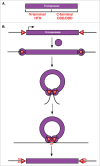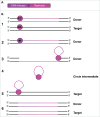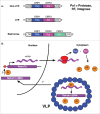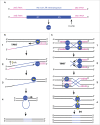Transposable elements in Drosophila
- PMID: 28580197
- PMCID: PMC5443660
- DOI: 10.1080/2159256X.2017.1318201
Transposable elements in Drosophila
Abstract
Transposable elements (TEs) are mobile genetic elements that can mobilize within host genomes. As TEs comprise more than 40% of the human genome and are linked to numerous diseases, understanding their mechanisms of mobilization and regulation is important. Drosophila melanogaster is an ideal model organism for the study of eukaryotic TEs as its genome contains a diverse array of active TEs. TEs universally impact host genome size via transposition and deletion events, but may also adopt unique functional roles in host organisms. There are 2 main classes of TEs: DNA transposons and retrotransposons. These classes are further divided into subgroups of TEs with unique structural and functional characteristics, demonstrating the significant variability among these elements. Despite this variability, D. melanogaster and other eukaryotic organisms utilize conserved mechanisms to regulate TEs. This review focuses on the transposition mechanisms and regulatory pathways of TEs, and their functional roles in D. melanogaster.
Keywords: LTR retrotransposons; P elements; TEs; TIR transposons; helitrons; non-LTR retrotransposons; retrovirus; transposons.
Figures






Similar articles
-
Structural and sequence diversity of eukaryotic transposable elements.Genes Genet Syst. 2020 Jan 30;94(6):233-252. doi: 10.1266/ggs.18-00024. Epub 2018 Nov 9. Genes Genet Syst. 2020. PMID: 30416149 Review.
-
Species-specific chromatin landscape determines how transposable elements shape genome evolution.Elife. 2022 Aug 23;11:e81567. doi: 10.7554/eLife.81567. Elife. 2022. PMID: 35997258 Free PMC article.
-
Widespread evidence for horizontal transfer of transposable elements across Drosophila genomes.Genome Biol. 2009 Feb 18;10(2):R22. doi: 10.1186/gb-2009-10-2-r22. Genome Biol. 2009. PMID: 19226459 Free PMC article.
-
Recombination rate and the distribution of transposable elements in the Drosophila melanogaster genome.Genome Res. 2002 Mar;12(3):400-7. doi: 10.1101/gr.210802. Genome Res. 2002. PMID: 11875027 Free PMC article.
-
Mammalian transposable elements and their impacts on genome evolution.Chromosome Res. 2018 Mar;26(1-2):25-43. doi: 10.1007/s10577-017-9570-z. Epub 2018 Feb 1. Chromosome Res. 2018. PMID: 29392473 Free PMC article. Review.
Cited by
-
TDP-43 prevents retrotransposon activation in the Drosophila motor system through regulation of Dicer-2 activity.BMC Biol. 2020 Jul 3;18(1):82. doi: 10.1186/s12915-020-00816-1. BMC Biol. 2020. PMID: 32620127 Free PMC article.
-
ONT-Based Alternative Assemblies Impact on the Annotations of Unique versus Repetitive Features in the Genome of a Romanian Strain of Drosophila melanogaster.Int J Mol Sci. 2022 Nov 28;23(23):14892. doi: 10.3390/ijms232314892. Int J Mol Sci. 2022. PMID: 36499217 Free PMC article.
-
Editorial: The epigenetic control of transposable elements in development and in diseases.Front Genet. 2023 Sep 4;14:1282449. doi: 10.3389/fgene.2023.1282449. eCollection 2023. Front Genet. 2023. PMID: 37732323 Free PMC article. No abstract available.
-
Evolutionary insights in Amazonian turtles (Testudines, Podocnemididae): co-location of 5S rDNA and U2 snRNA and wide distribution of Tc1/Mariner.Biol Open. 2020 Apr 28;9(4):bio049817. doi: 10.1242/bio.049817. Biol Open. 2020. PMID: 32229487 Free PMC article.
-
The Role of HSP90 in Preserving the Integrity of Genomes Against Transposons Is Evolutionarily Conserved.Cells. 2021 May 4;10(5):1096. doi: 10.3390/cells10051096. Cells. 2021. PMID: 34064379 Free PMC article. Review.
References
-
- Pagel M, Johnstone RA. Variation across species in the size of the nuclear genome supports the junk-DNA explanation for the C-value paradox. Proc Biol Sci 1992; 249:119-24; PMID:1360673; https://doi.org/10.1098/rspb.1992.0093 - DOI - PubMed
-
- Vieira C, Nardon C, Arpin C, Lepetit D, Biemont C. Evolution of genome size in Drosophila. Is the invader's genome being invaded by transposable elements? Mol Biol Evol 2002; 19:1154-161; PMID:12082134 - PubMed
-
- Bosco G, Campbell P, Leiva-Neto JT, Markow TA. Analysis of Drosophila species genome size and satellite DNA content reveals significant differences among strains as well as between species. Genetics 2007; 177:1277-90; PMID:18039867; https://doi.org/10.1534/genetics.107.075069 - DOI - PMC - PubMed
-
- Gregory TR, Johnston JS. Genome size diversity in the family Drosophilidae. Heredity (Edinb) 2008; 101:228-38; PMID:18523443; https://doi.org/10.1038/hdy.2008.49 - DOI - PubMed
-
- SanMiguel P, Tikhonov A, Jin YK, Motchoulskaia N, Zakharov D, Melake-Berhan A, Springer PS, Edwards KJ, Lee M, Avramova Z, et al.. Nested retrotransposons in the intergenic regions of the maize genome. Science 1996; 274:765-8; PMID:8864112 - PubMed
Publication types
LinkOut - more resources
Full Text Sources
Other Literature Sources
Molecular Biology Databases
Research Materials
